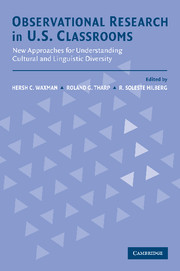 Observational Research in U.S. Classrooms
Observational Research in U.S. Classrooms Book contents
- Frontmatter
- Contents
- Tables, Figures, and Appendixes
- Contributors
- 1 Introduction: Purposes and Perspectives on Classroom Observation Research
- 2 Using Multiple Perspectives in Observations of Diverse Classrooms: The Sheltered Instruction Observation Protocol (SIPO)
- 3 The Standards Performance Continuum: A Performance-Based Measure of the Standards for Effective Pedagogy
- 4 The Uses of the Classroom Observation Schedule to Improve Classroom Instruction
- 5 Development and Use of a Classroom Observation Instrument to Investigate Teaching for Meaning in Diverse Classrooms
- 6 Patterns of Language Arts Instructional Activity and Excellence in First– and Fourth–Grade Culturally and Linguistically Diverse Classrooms
- 7 Using Classroom Observation as a Research and Formative Evaluation Tool in Educational Reform: The School Observation Measure
- 8 Observing School Restructuring in Multilingual, Multicultural Classrooms: Balancing Ethnographic and Evaluative Approaches
- 9 Sociocultural Activity Settings in the Classroom: A Study of a Classroom Observation System
- 10 The Influence of School Reform on Classroom Instruction in Diverse Schools: Findings from an Observational Study of Success for All
- 11 Future Directions for Classroom Observation Research
- Index
- References
5 - Development and Use of a Classroom Observation Instrument to Investigate Teaching for Meaning in Diverse Classrooms
Published online by Cambridge University Press: 23 November 2009
- Frontmatter
- Contents
- Tables, Figures, and Appendixes
- Contributors
- 1 Introduction: Purposes and Perspectives on Classroom Observation Research
- 2 Using Multiple Perspectives in Observations of Diverse Classrooms: The Sheltered Instruction Observation Protocol (SIPO)
- 3 The Standards Performance Continuum: A Performance-Based Measure of the Standards for Effective Pedagogy
- 4 The Uses of the Classroom Observation Schedule to Improve Classroom Instruction
- 5 Development and Use of a Classroom Observation Instrument to Investigate Teaching for Meaning in Diverse Classrooms
- 6 Patterns of Language Arts Instructional Activity and Excellence in First– and Fourth–Grade Culturally and Linguistically Diverse Classrooms
- 7 Using Classroom Observation as a Research and Formative Evaluation Tool in Educational Reform: The School Observation Measure
- 8 Observing School Restructuring in Multilingual, Multicultural Classrooms: Balancing Ethnographic and Evaluative Approaches
- 9 Sociocultural Activity Settings in the Classroom: A Study of a Classroom Observation System
- 10 The Influence of School Reform on Classroom Instruction in Diverse Schools: Findings from an Observational Study of Success for All
- 11 Future Directions for Classroom Observation Research
- Index
- References
Summary
As the number of states and local school districts requiring high-stakes testing grows, controversy intensifies around the issue of the impact of such testing on the quality of instruction and on the education of the students who ostensibly are its intended beneficiaries (National Research Council, 1999; Sadowski, 2000). Many parents, students, and educators express concerns about the emphasis on improving the passing rates on high-stakes tests (Rose & Gallup, 2000; Schrag, 2000). They fear that such a focus militates against good instruction and tends to reduce the scope of the curriculum to that which is tested. Implicit in these concerns is the assumption that getting good results on the tests requires repetitive drill and practice on isolated skills and content to the exclusion of what might be termed teaching for meaning. These concerns also assume that teaching for meaning will result in poorer performance on the tests.
Particularly troubling is the effect on those students who experience difficulty with learning, live in high-poverty conditions, and represent a diversity of cultural and linguistic backgrounds. Educators use various terms to describe these students (at risk, educationally disadvantaged, marginal, etc.) to capture the disconnection between students and the conditions designed for their learning. Typically, although attention may be directed to their needs, little effort has been expended to identify and build on the assets that they bring with them from their diverse backgrounds (Levin, 1987).
- Type
- Chapter
- Information
- Observational Research in U.S. ClassroomsNew Approaches for Understanding Cultural and Linguistic Diversity, pp. 97 - 121Publisher: Cambridge University PressPrint publication year: 2004
References
- 1
- Cited by


